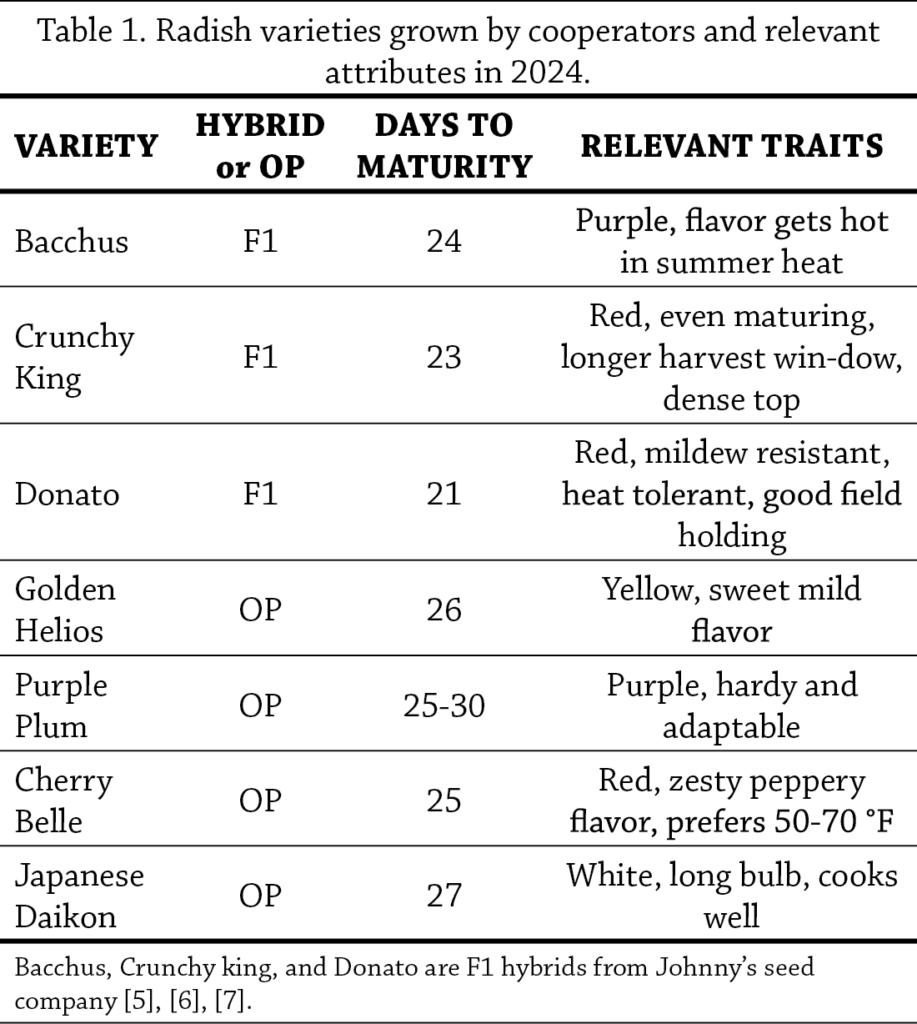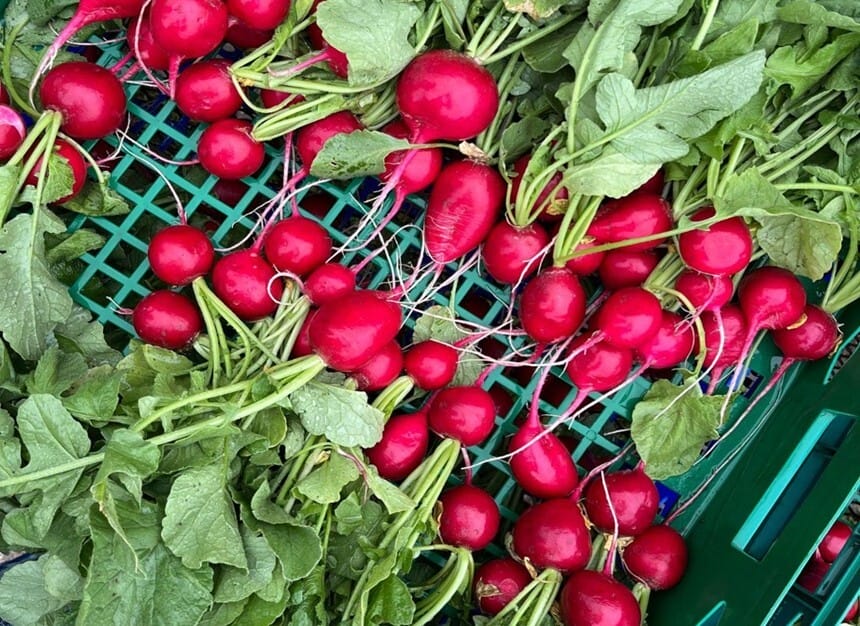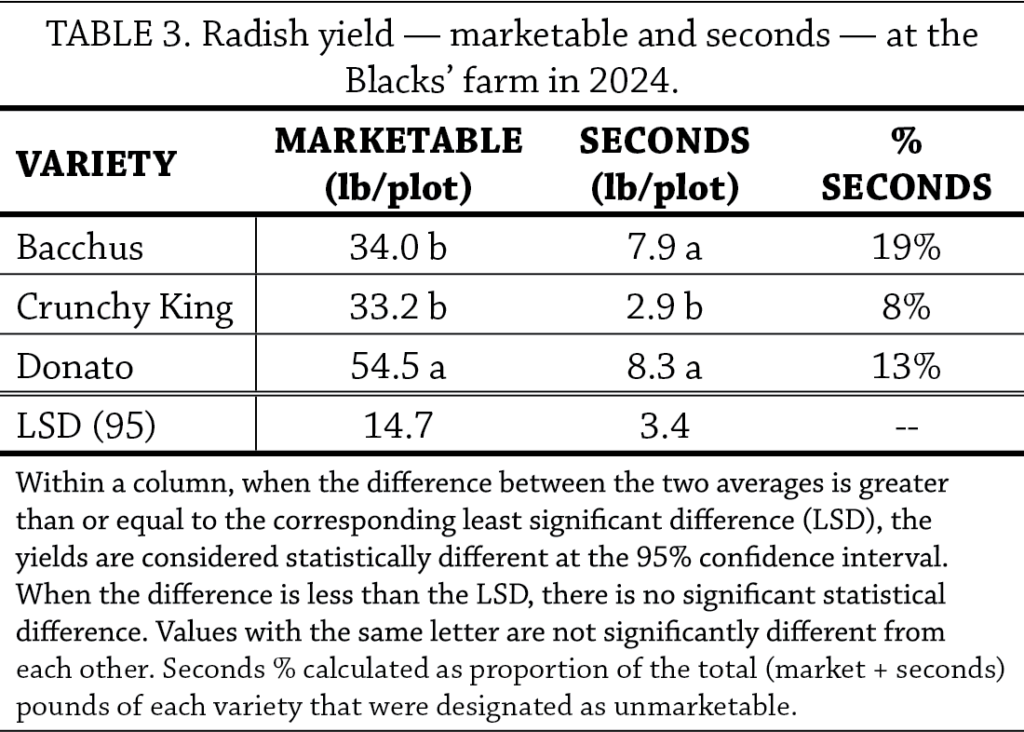This research report was funded by IDALS and Ceres Trust.
In a Nutshell:
- Heat decreases radish marketable harvest yield and quality, causing plants to bolt, roots to get woody, and flavor to get sharp and bitter.
- Carmen & Maja Black and Terry Troxel tested 7 varieties of radishes for their heat tolerance, investigating whether they could be planted as summer radishes to meet summer demand for fresh local vegetables.
Key Findings
- Troxel, who harvested throughout the summer, found that high August temperatures drove down yields due to bolting.
- Daikon stood out for Troxel as heat-tolerant and high yielding.
- The Blacks had the highest yields from Donato.
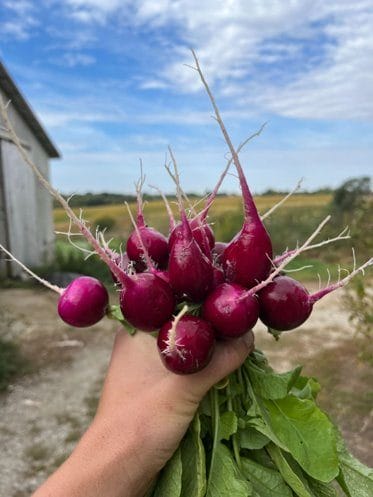
Radishes harvested, washed, and ready for bunching for sale. Photo taken at Blacks’ farm, July 2024.
Background
Heat tolerance has been the subject of previous PFI trials for broccoli, head lettuce and cabbage [1], [2], [3]. This year the focus was on radishes, as Iowa farmers aim to establish optimal practices to grow local produce throughout the summer.
Radishes grow well in cooler conditions. Heat and drought conditions rob the swollen taproot of the moisture which makes it juicy and tender. Heat stress also triggers bolting in radishes, when the plant shifts life-strategy paths, supporting flowers and going to seed. This reduces the amount of energy that the plant stores in the root, again reducing the quality of taproot [4].
Cooperators trialed several different strains of radishes to see which would best handle the summer heat. Troxel hoped to add diversity to her cropping system and CSA lineup. Carmen Black cited seed companies’ focus on coastal production areas as a reason for suboptimal applicability and accuracy of advice, prescribed practices, and varietal traits. Conducting this study in Iowa, she hoped to identify varieties that would perform well in the local conditions.
There are several possible criteria that can be used to evaluate the radish varieties. These include:
- Taste – this can range from mild to peppery; hot growing conditions tend to lead to more ‘hot’, peppery, bitter, radishes
- Radish appearance – the ideal is blemish-free and regularly shaped spheres, with vibrant exterior colors and white flesh
- Field hold – radishes with a wider window before they start to get woody or mealy make it easier to have a more marketable harvest
- Even maturation and harvest – reduces the work of managing readiness within the plot and the risk of missing the harvest window for part of the crop
- Stem strength – this is important for ‘bunching’ the radishes for sale and distribution
- Heat tolerance – as noted above, heat negatively affects several of these criteria. The goal of this trial is to identify radishes that can be grown in the Iowa summer.
Methods
Design
The cooperators tested the following radish varieties: Bacchus, Crunchy King, Donato, Golden Helios, Purple Plum, Cherry Belle, and Japanese Daikon (Table 1). The plot layouts used in the Blacks’ experiment are shown in Table A1. Troxel planted three successions of radishes between April and June but did not replicate variety treatments. Treatment plot sizes and management details for each farm are shown in Table 2.
Measurements
Both farms collected yield data by plot, measuring the weight of all marketable radishes, with their tops, from each plot. The Blacks also weighed those radishes that were harvested that were not marketable, categorized as ‘seconds’. Troxel evaluated the strength of the stems as either: 1–unacceptable, 2–acceptable, or 3–preferred. Troxel also documented the proportion of plants of each variety that had bolted at harvest.
Data analysis
We used Fischer’s LSD at a 95% confidence level to determine if there were significant differences between varieties. For each metric, the difference between any two varieties was compared with the LSD. A difference greater than or equal to the LSD indicates the presence of a statistically significant treatment effect, meaning one treatment outperformed the other and the farmer can expect the same results to occur 95 out of 100 times under the same conditions. A difference smaller than the LSD indicates the difference is not statistically significant and the treatment had no effect. We can perform this analysis because the cooperators had completely randomized and replicated experimental designs (Figure A1). We could not perform statistical analyses on Troxel’s results due to lack of replication.
Results and Discussion
Black
The Blacks had significantly higher marketable yield from Donato, compared to Crunchy King and Bacchus (Figure 1). Crunchy King had significantly less seconds than Donato and Bacchus (Table 3).
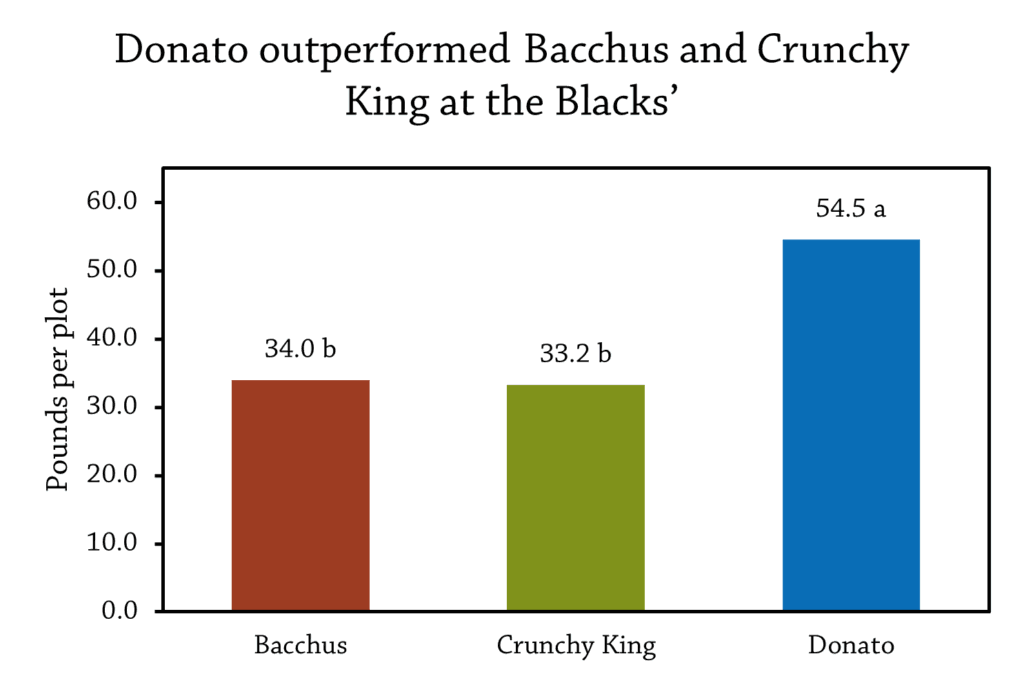
Figure 1. Cumulative radish yields across all harvest dates at Carmen & Maja Black’s in 2024. Above each column is the variety average. Where the averages of any two treatments differ by more than the least significant difference (LSD = 14.7 lb/plot) the yields do not share any similar letters and are considered statistically different at the 95% confidence level. Where yield differences are less than the LSD, the yields share similar letters and are considered statistically similar.
Troxel
Troxel’s harvest spanned early May to mid-October across the three successions (Figure 2). The first planting succession yielded a total of 443 pounds of marketable radishes. The second succession yielded 662 total pounds of marketable radishes of all varieties. The third planting succession saw a strong decrease in yields to 279 pounds, with Cherry Belle and Helios not yielding any radishes because they had all bolted, likely owing to climbing temperatures in August (Figure A2). Although Purple Plum yields were lower in succession 3 due to bolting, it did produce 77 pounds of marketable radishes, in contrast with Cherry Belle and Helios (Figure 2). It is clear that once bolting has started in the group, yield does not recover. Daikon resisted bolting and thereby maintained its high yields.
Daikon has a different development and cultivation history from the other varieties in this trial, being Japanese where the other varieties a based on European varieties. Daikon (which means ‘radish’ in Japanese) grow larger than the other varieties—Troxel noted that some individuals could be sliced like loaves of bread. Daikon increased its yield through the three successions, topping out at 202 pounds in the third succession.

Figure 2: Radish yields from each succession 1 (May-June); 2 (June-Aug.); and 3 (Aug.-Oct.) at Terry Troxel’s in 2024. Values above the columns are the cumulative yields of each variety in a succession. No statistical analysis could be made due to lack of replication.
Stem strength
Because the strength of the radish stem is important for bundling radishes into bunches for sale or distribution, the cooperators evaluated stem strength among varieties across the project. The Blacks did not find any of the stems to be problematic. Troxel found that stem strength decreased through the summer. The daikon radishes, whose yields resisted the summer heat, also maintained the highest stem strength, never dipping below an ‘acceptable’ rating.
Conclusions and Next Steps
Carmen & Maja Black found that they had a better harvest from the June planted radishes than from their more traditional April planting (not reported as part of this trial). Donato was the highest yielding variety, but all three varieties performed well. Carmen Black mentioned it was nice to have both purple and red radishes in bunches. In the future they will allocate more space in the crop rotation for June and July radishes than for March and April radish plantings.
Troxel was pleased with the performance and market acceptance of Daikon radishes. Participating in the trial gave her experience growing and marketing radishes that would enable her to expand the role radishes play in her crop rotation going forward.
Appendix – Trial Design and Weather Conditions

Figure A2. Monthly cumulative precipitation and average temperatures in Solon (Black) and Crescent (Troxel) during the radish growing season, May 2024 – August 2024 [8], [9].
Funding for this project was made possible by a grant/cooperative agreement from the U.S. Department of Agriculture (USDA) Agricultural Marketing Service. Its contents are solely the responsibility of the authors and do not necessarily represent the official views of the USDA.
References
[1] “Summer Broccoli Variety Trial,” Practical Farmers of Iowa. Accessed: Feb. 13, 2025. [Online]. Available: https://practicalfarmers.org/research/summer-broccoli-variety-trial/
[2] “Summer Lettuce Variety Trial,” Practical Farmers of Iowa. Accessed: Feb. 13, 2025. [Online]. Available: https://practicalfarmers.org/research/summer-lettuce-variety-trial-2/
[3] “Cabbage Variety Trial,” Practical Farmers of Iowa. Accessed: Feb. 13, 2025. [Online]. Available: https://practicalfarmers.org/research/cabbage-variety-trial/
[4] “Growing radishes in home gardens.” Accessed: Feb. 14, 2025. [Online]. Available: https://extension.umn.edu/vegetables/growing-radishes
[5] “Bacchus – (F1) Purple Radish Seeds | Johnny’s Selected Seeds.” Accessed: Feb. 13, 2025. [Online]. Available: https://www.johnnyseeds.com/vegetables/radishes/round-radishes/bacchus-f1-radish-seed-3675.html?srsltid=AfmBOoo0ay4DPmbshFlUT4SAzE2ZfJTJwlYwIOdu6cBE9loe-CuYk8T8
[6] “Crunchy King – (F1) Radish Seed | Johnny’s Selected Seeds.” Accessed: Feb. 13, 2025. [Online]. Available: https://www.johnnyseeds.com/vegetables/radishes/round-radishes/crunchy-king-f1-radish-seed-3414.html?srsltid=AfmBOopXKy8J8daNGyWL3UoGDIWtCQcE5EhXXTp-rpyRrA5sDM5L-5r1
[7] “Donato – (F1) Radish Seed | Johnny’s Selected Seeds.” Accessed: Feb. 14, 2025. [Online]. Available: https://www.johnnyseeds.com/vegetables/radishes/round-radishes/donato-f1-radish-seed-4910.html?srsltid=AfmBOopXZ98oaOYLc8NEatdw0CulCasb5N8gF1cyEf9QRpDGsNGNR2Pw
[8] A. H. Sparks, “nasapower: A NASA POWER Global Meteorology, Surface Solar Energy and Climatology Data Client for R,” J. Open Source Softw., vol. 3, no. 30, p. 1035, Oct. 2018, doi: 10.21105/joss.01035.
[9] A. Sparks, nasapower: NASA-POWER Data from R. (2024). [Online]. Available: https://CRAN.R-project.org/package=nasapower


